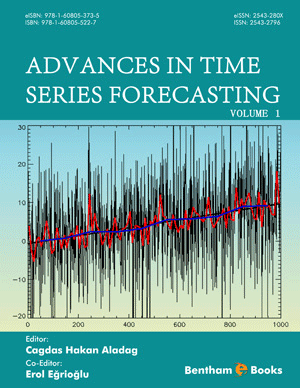Contributors
Page: iii-iii (1)
Author: HULYA CINGI and CEM KADILAR
DOI: 10.2174/978160805012310901010iii
Abstract
Full text available
Ratio Estimators For The Population Mean In The Simple Random Sampling
Page: 1-20 (20)
Author: Hulya Cingi and Cem Kadilar
DOI: 10.2174/978160805012310901010001
PDF Price: $15
Abstract
Statisticians have proposed efficient estimators for the population parameters for last 5 decades. The concept of “efficient” is a vital key word for an estimator and it depends on the “Mean Square Error (MSE)”. Therefore, the fundamentals of the MSE in Statistics should be known exactly. For this reason, Chapter 1 discusses the basic formula of the MSE and explains how to apply this formula to the estimators in Sampling Theory to find the approximate MSE equations for these estimators. For this illustration, The Classical Ratio Estimator, Searls Estimator, Prasad Estimator, Sisodia – Dwivedi Estimator, Singh – Kakran Estimator and Upadhyaya – Singh Estimator are used. Obtaining the MSE equations, the efficiencies of these estimators are also compared in theory and in applications.
Ratio Estimators For The Population Variance In The Simple Random Sampling
Page: 21-38 (18)
Author: Hulya Cingi and Cem Kadilar
DOI: 10.2174/978160805012310901010021
PDF Price: $15
Abstract
The estimation of the population variance from a sample is also a popular topic for Statisticians as the estimation of the population mean. Therefore, in Chapter 2, the estimators on this topic such as Hirano, Isaki, Prasad – Singh, and Garcia – Cebrain are examined in detail deriving the MSE equations of these estimators. In these derivations, it is worth mentioning that the variance and the covariance functions for estimators of the population variance are very complicated so in this chapter these functions are explained in a clear way to understand how to get the MSE equations. The efficiency conditions for these estimators are also obtained and the application supports these theoretical findings.
Complex Estimators In The Simple Random Sampling
Page: 39-66 (28)
Author: Hulya Cingi and Cem Kadilar
DOI: 10.2174/978160805012310901010039
PDF Price: $15
Abstract
To propose a new estimator, the proposed estimator should be shown that it is more efficient than the estimators in literature. Therefore, obtaining the MSE of the proposed estimator is obligatory. For this reason, in Chapter 3, the Taylor Series Method, which is the most popular method in literature for finding the MSE of the estimators, is explained in detail. All alternative techniques for this method are also discussed. The necessary notations for these techniques are presented. For the illustration of the usage of the method, many estimators in literature are used such as Kaur regression estimator, Kadilar – Cingi ratio estimators, Singh – Chaudhary estimator having two auxiliary variables, Ray – Singh and Bahl – Tuteja estimators having auxiliary attribute, Singh – Horn estimator in the case of the missing data and many more. The general form of the Taylor Series Method is also studied in this chapter.
Chain Estimators In The Simple Random Sampling
Page: 67-77 (11)
Author: Hulya Cingi and Cem Kadilar
DOI: 10.2174/978160805012310901010067
PDF Price: $15
Abstract
Some authors try to use the same type of estimator more than once to find the estimate of the population parameter. In literature, these estimators are called chain estimators. Statisticians see that the estimator having the power of alpha gets more efficient than the estimators without power. By this realization, popularity of the chain estimators has increased. In Chapter 4, the studies on this kind of estimators are reviewed such as Srivastava (1967), Rao (1991), Garcia and Cebrain (1996), Kadilar and Cingi (2003), Abu Dayeh et al. (2003), Chandra and Singh (2005), Turgut and Cingi (2008).
Estimators In The Ranked Set Sampling
Page: 78-91 (14)
Author: Hulya Cingi and Cem Kadilar
DOI: 10.2174/978160805012310901010078
PDF Price: $15
Abstract
Ranked Set Sampling (RSS) is an alternative design of the Simple Random Sampling. The RSS design has some advantages according the Simple Random Sampling. For example, by this design, efficient estimates can be obtained using less data in the sample. In Chapter 5, the usage of this practical design is explained and some basic estimators are examined in RSS. In addition, the ratio and the regression estimators are also studied for this design. By a problem given in this chapter, the readers can understand how to apply the RSS design to the data and the estimation stage completely.
Estimators In The Stratified Random Sampling
Page: 92-116 (25)
Author: Hulya Cingi and Cem Kadilar
DOI: 10.2174/978160805012310901010092
PDF Price: $15
Abstract
The Stratified Random Sampling is a well-known design in sampling theory. Especially, after the study of Kadilar and Cingi (2003), the adaptations of ratio estimators to the Stratified Random Sampling have increased seriously. In Chapter 6, the studies on the estimators in the Stratified Random Sampling are analyzed such as Shabbir and Gupta (2005; 2006), Singh and Vishwakarma (2006), Kadilar and Cingi (2006), Singh et al. (2008), Koyuncu and Kadilar (2009). The efficiencies of these estimators are also discussed in theory and in application.
References
Page: 117-121 (5)
Author: HULYA CINGI and CEM KADILAR
DOI: 10.2174/978160805012310901010117
PDF Price: $15
Abstract
Full text available
Introduction
This is an ideal textbook for researchers interested in sampling methods, survey methodologists in government organizations, academicians, and graduate students in statistics, mathematics and biostatistics. This textbook makes advanced topics easy to grasp for the readers. Many theoretical discussions about the latest estimators in literature are incorporated into almost all the chapters. This feature helps the academicians acquire necessary skills to follow up recent studies on their own. More than just an introductory text, the reader, who has mastered the contents of this book, should attain a level so as to be able to make a major contribution to the technical and research literature of sampling theory.












